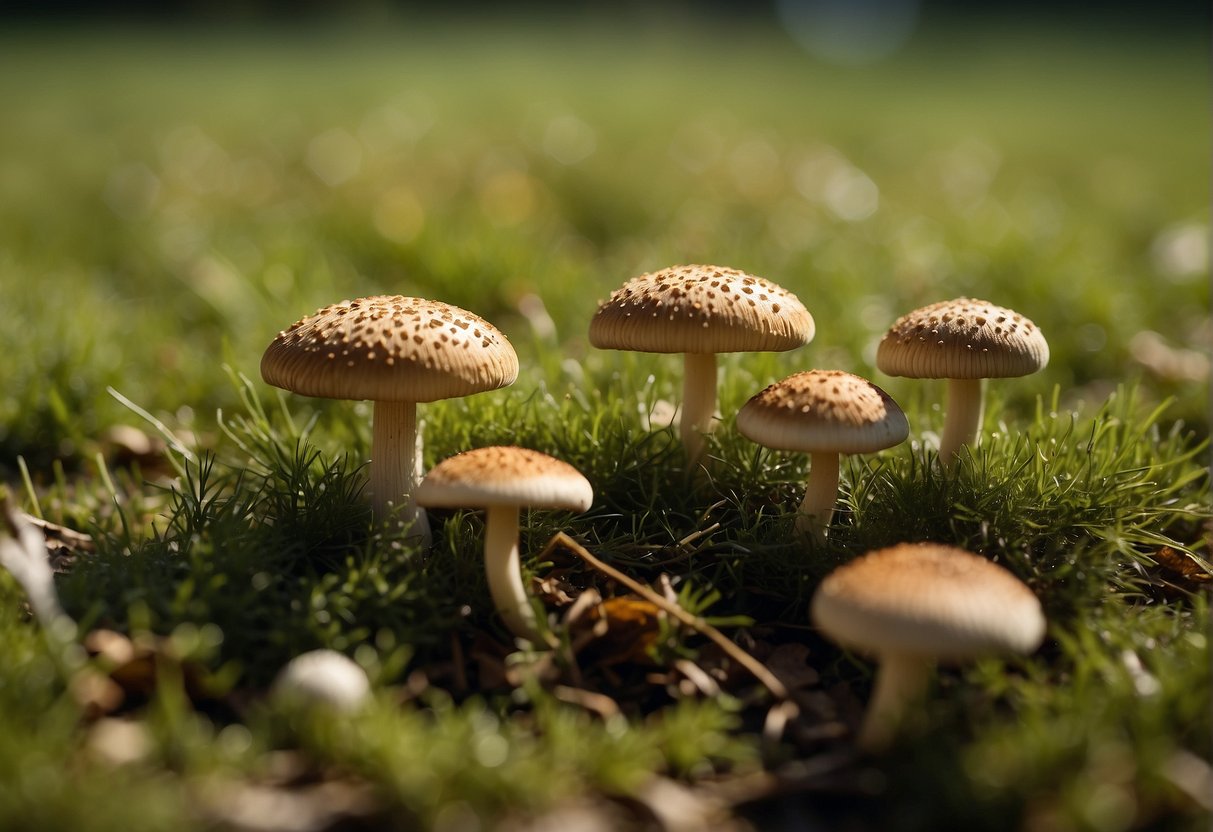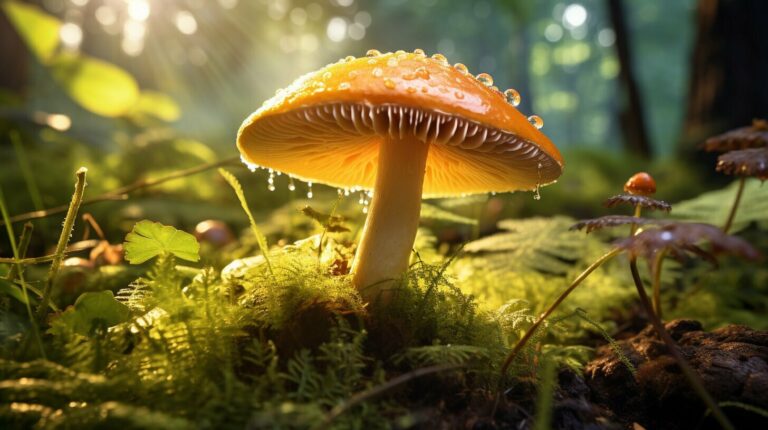Identifying lawn mushrooms is an important task for both garden enthusiasts and homeowners who wish to maintain a healthy yard. Your lawn is an ecosystem that supports a variety of organisms, including fungi, which can appear as mushrooms. These mushrooms emerge from the soil and organic matter in your lawn, indicating the presence of nutrients and ongoing biological processes. While some mushrooms can be beneficial to your lawn by breaking down organic matter and recycling nutrients, others may be undesirable or even harmful.
When you see mushrooms sprouting in your grass, it’s crucial to approach their identification with care. A correct identification can inform you whether the mushrooms are harmless, beneficial to your lawn’s health, or potentially toxic if you have children or pets. Understanding the characteristics of lawn mushrooms, such as cap shape, color, size, and where they grow, can help you in determining their species. Some may grow solitary, while others appear in clusters, and they can vary widely in appearance.
To assist you in identifying the various species that may appear on your lawn, there are comprehensive guides available. These guides can be valuable resources, providing clear pictures and descriptions that help differentiate between the many types of mushrooms you might encounter in your yard. Through careful observation and the use of identification resources, you can become more knowledgeable about the mushrooms that share your outdoor space.
Basics of Lawn Mushroom Identification
Table of Contents

When you begin the task of identifying lawn mushrooms, the essential skills to master are an understanding of the mushroom’s anatomy and learning to recognize common characteristics specific to those that grow in lawns.
Understanding Mushroom Anatomy
- Cap Shape: The cap, or the top of the mushroom, can vary widely and is an important identifying feature. Pay attention to whether it’s flat, bell-shaped, convex, or has indentations.
- Gills or Pores: Look underneath the cap. Mushrooms have either gills, which are the thin, blade-like structures, or pores, small tubes that release spores. Note the color and attachment to the stalk as it aids in identification.
- Stalk (Stipe): The stalk supports the cap and can hold clues to the mushroom’s identity. Its length, thickness, whether it has a ring, and its texture are all relevant details.
- Texture and Odor: Some mushrooms have a distinctive surface texture and odor that can help you identify them. Example textures range from slimy to dry, while odors can be earthy, musty, or even unpleasant.
Recognizing Common Lawn Mushroom Characteristics
- Color: Lawn mushrooms can come in a variety of colors. Take note of both the cap and stalk color since they may differ.
- Clusters: Do the mushrooms grow solitary, or are they in clusters? Their growth pattern can provide you with clues.
- Grass and Lawns: Examine the surrounding area; mushrooms can have preferences for certain types of grass or soil conditions.
When identifying lawn mushrooms, incorporate all these features to arrive at a correct identification, understanding that the variety of types of lawn mushrooms can be extensive, and careful observation is key.
Identifying Edible Vs. Toxic Species
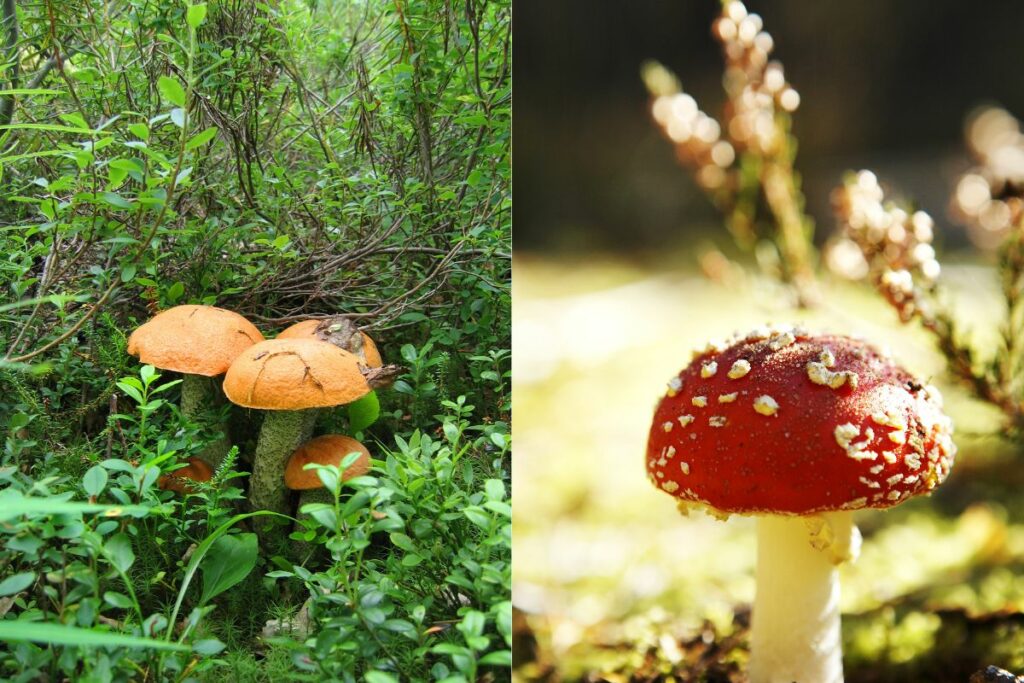
Mushroom foraging can be an enriching experience, yet it demands diligence. It’s crucial to distinguish edible mushrooms from their toxic counterparts to avoid potential hazards.
Key Features of Edible Mushrooms
Edible Mushrooms such as the Meadow Mushroom (Agaricus campestris), Shaggy Ink Cap (Coprinus comatus), and Fairy Ring Mushroom (Marasmius oreades) have distinct characteristics.
- Agaricus campestris:
- Appearance: Pink gills that darken to brown with maturity, white to off-white cap, firm texture.
- Habitat: Found in grassy areas like meadows or lawns.
- Coprinus comatus:
- Appearance: Tall, cylindrical white cap that becomes inky with age, edible only in its “shaggy” stage.
- Habitat: Thrives in disturbed grounds, such as woodchip beds and garden soil.
- Marasmius oreades:
- Appearance: Small, with convex caps and a distinctive central dimple at maturity. Cream or light brown color.
- Habitat: Forms fairy rings in lawns and grassy areas.
Morel Mushrooms (Common Morel Morchella esculenta) and Parasol Mushroom (Macrolepiota procera) are also edible, with the former being spongy and the latter bearing a tall, prominent stem and a large, umbrella-like cap.
Dangers of Toxic and Inedible Mushrooms
Toxic Mushrooms, such as the Destroying Angel (Amanita sp.) and Green-Spored Lepiota (Chlorophyllum molybdites), pose significant risks. These species can be easily mistaken for edible varieties by inexperienced foragers and can cause severe poisoning or even death if consumed.
- Destroying Angel (Amanita sp.):
- Appearance: White, with a smooth cap and white gills; resembles edible species such as Agaricus.
- Toxicity: Contains deadly amatoxins, leading to severe liver and kidney damage.
- Chlorophyllum molybdites:
- Appearance: Similar to edible Parasol mushrooms, but distinguished by its green spore print.
- Toxicity: Causes gastrointestinal distress and should be avoided.
It’s imperative to thoroughly identify mushrooms using multiple sources, like The Mushroom Hunter’s Field Guide, before considering them safe to eat. Consult authoritative guides and, if possible, seek expertise from experienced mycologists to ensure the safe identification of edible species. Remember, when in doubt, it’s best to leave the mushroom where you found it.
Environmental Factors Affecting Mushroom Growth
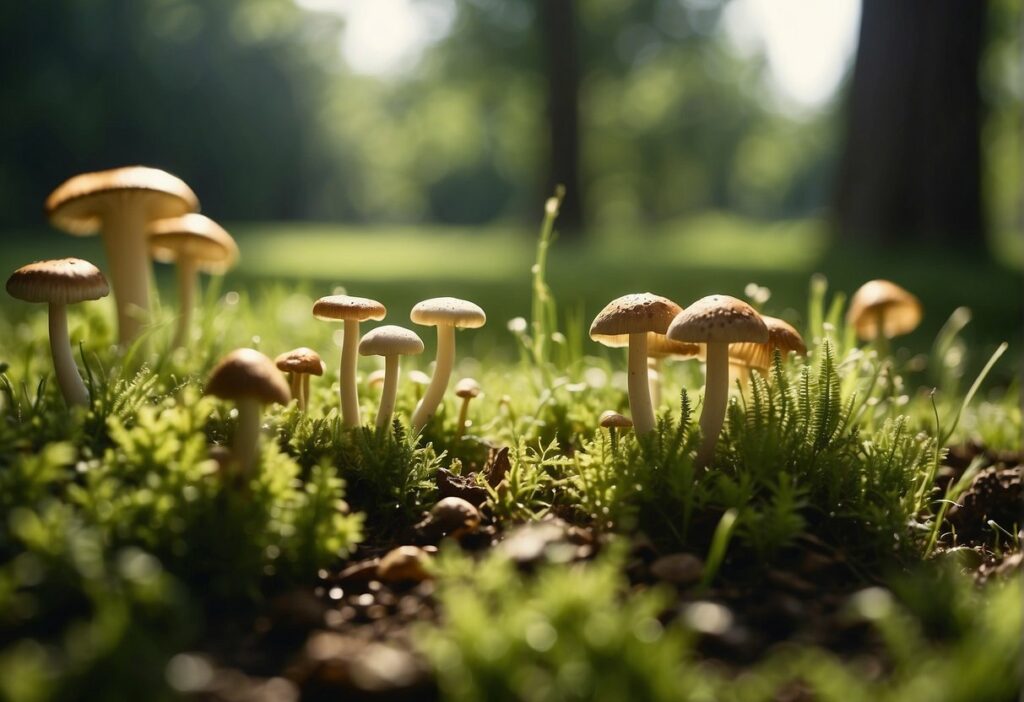
Mushroom growth in your lawn depends on a variety of environmental conditions that interact with one another. Understanding these factors can help you identify and support—or if necessary, manage—the types of mushrooms that appear on your property.
The Role of Weather and Season
Mushrooms flourish in your lawn during specific periods of the year, notably fall and summer, when the temperature and moisture conditions are just right. Different species may prefer either the cooler, damp environment of the autumn or the warmer, yet still moist conditions of the summertime.
Soil Composition and Health
The health of your lawn’s soil directly impacts mushroom growth. A rich composition with adequate organic matter and nutrients supports a diverse ecosystem. Thatch buildup can either facilitate or inhibit mushroom development, depending on the mushroom species and their ecological role, such as decomposing organic materials.
Influence of Surrounding Flora
Trees, particularly species like birch, can influence the types of mushrooms that appear, as many form symbiotic relationships with specific trees. Decaying wood and stumps in meadows or fields can also introduce spores to your lawn, fostering different fungal communities.
Water and Drainage Conditions
Mushrooms thrive in environments with appropriate moisture, but poor drainage can lead to excessive water accumulation, which might support the growth of undesired fungi. Proper drainage ensures a balance that can support a healthy lawn ecosystem without encouraging harmful mushroom species.
Special Types of Mushroom Formations
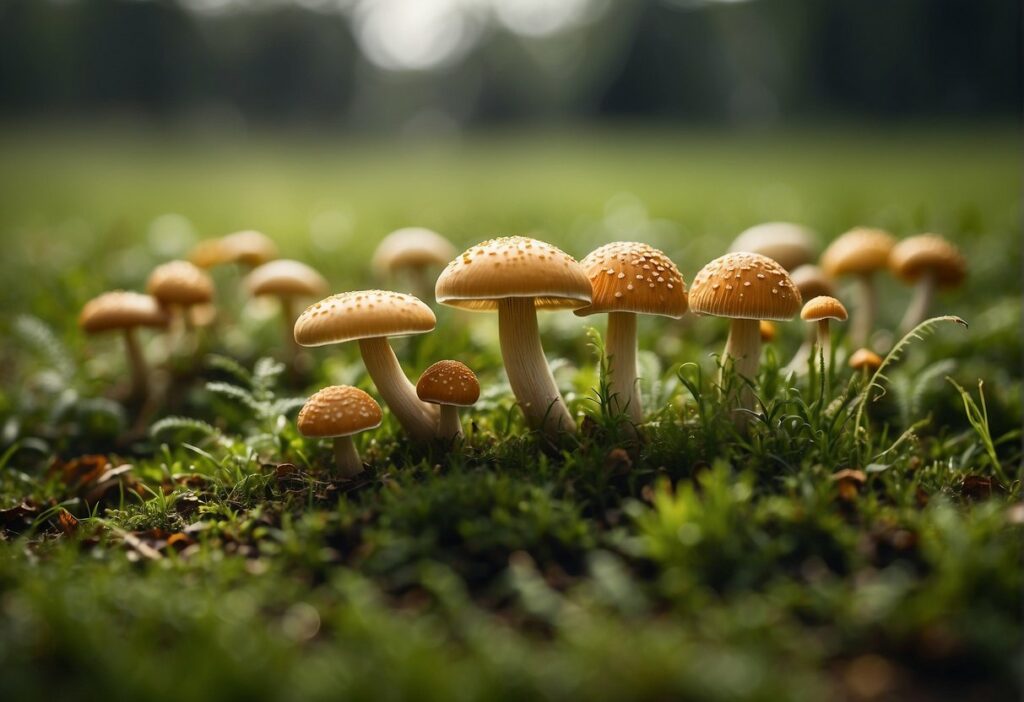
When you encounter mushrooms in your lawn, you’re actually seeing a variety of sophisticated fungal organisms at work. Their formations can indicate different things about your lawn’s health and the ecosystem beneath.
Understanding Fairy Rings
Mushrooms such as the Marasmius oreades often grow in a curious pattern known as a fairy ring. This circular formation can be spotted in meadows and grassy lawns as a visible arc or full ring of mushrooms. The fairy ring is a result of the mushrooms spreading out from a central point in the soil, where the fungus began, using up the nutrients and expanding in search of more organic matter.
Clusters and Their Significance
Mushroom clusters, dense groups of fungi, typically signify an abundance of organic matter within the soil. These clusters can often be found where tree stumps once were or in areas with high organic debris. They can vary in appearance, with some mushrooms like the slimy cluster of tall Coprinus comatus commonly known as the shaggy ink cap.
Unique Growth Habits of Lawn Mushrooms
Each lawn mushroom species has its unique growth habits which can range from solitary to clustered formations. Their appearance can often give you clues about your lawn’s condition. For instance, a mushroom that favors moisture may indicate overly wet conditions in your lawn.
Remember to identify lawn mushrooms with care. Accurate identification often requires examining specific features such as cap size, color, and gill formation. If ever in doubt, consulting a field guide or an expert can provide further insights.
Associative and Parasitic Mushroom Relationships
When exploring your lawn for mushrooms, you’ll encounter diverse fungi, some forming mutualistic relationships while others act as parasites.
Mycorrhizal Fungi and Their Hosts
Mycorrhizal fungi form a crucial, symbiotic relationship with the trees in your ecosystem. These fungi, including diverse mushrooms, attach to tree roots, expanding their ability to absorb water and nutrients. In return, the tree provides the fungi with carbohydrates needed for growth. The honey fungus (Armillaria mellea), for instance, is a mycorrhizal fungus that can also behave parasitically under stressful conditions.
Parasitic Species and Host Impact
In contrast, parasitic mushrooms directly harm their hosts. Stinkhorn fungus (Phallus impudicus) and mushrooms like Agaricus placomyces may not form mutualistic relationships and can siphon off nutrients from plants without providing benefits in return. This can lead to a weakened host and, in some cases, the death of the plant, illustrating the delicate balance within the ecosystem.
Advanced Identification Techniques
When you’re identifying lawn mushrooms, precise techniques can make all the difference. Key methods such as analyzing spore prints, leveraging sensory observations, and employing scientific tools are crucial for accurate identification.
Using Spore Prints for Identification
To identify lawn mushrooms, you can create spore prints which reveal the color and pattern unique to a species. Place the cap, gills facing down, on a piece of paper and cover it to block airflow. After a few hours to overnight, uncover it to assess the spore deposit’s hue, ranging from white to dark brown, which aids identification.
Sensory Cues: Smell and Texture
The texture and smell of a mushroom are valuable sensory cues for identification. A lawn mushroom may have a fleshy or fibrous texture, while odors can range from earthy to the unmistakable foul odor of rotting flesh. It’s important to note these characteristics carefully, as they can be as distinctive as visual markers.
Scientific Methods and Resources
For a more advanced approach to identifying lawn mushrooms, scientific methods and resources are available. Tools like dichotomous keys take you through a series of choices based on characteristics such as gills, texture, and odors. Reliable online databases and guides, like those found in “California mushrooms: The comprehensive identification guide,” deepen your knowledge with detailed images and descriptions for comparison.
Frequently Asked Questions
When identifying mushrooms in your lawn, it’s crucial to recognize various species and discern whether they are safe. This section provides answers to commonly asked questions about lawn mushroom identification.
What are the characteristics of poisonous mushrooms found in lawns?
Poisonous mushrooms can exhibit features like white gills, a ring on the stem, and a bulbous or sack-like base. Always exercise caution, as characteristics can be misleading without expert knowledge.
How can tall mushroom species commonly found in gardens be identified?
Identification of tall mushrooms often involves examining their cap shape, stem length, color, and any unique features like scales or a slimy surface. Reference materials, like Texas mushrooms: a field guide, can aid in identifying these garden varieties.
Which mushrooms are common in Michigan lawns and how can they be recognized?
In Michigan, common lawn mushrooms include the morel, which has a honeycomb appearance, and the puffball, which is round and lacks gills. Resources like Michigan’s mushroom hunting field guide can provide visual aids for identification.
Can you distinguish between edible and poisonous white mushrooms found in yards?
Yes, but it requires careful examination of spore color, cap and stem features, and where the mushroom is growing. For safety, consult reputable guides or a mycologist before consumption.
What steps are involved in using a picture to identify a mushroom variety?
To identify a mushroom variety from a picture, examine the mushroom’s features, compare with images from a trusted field guide, and cross-reference with documented characteristics of the species in question.
Is there a difference between mushrooms and toadstools in terms of identification?
The term ‘toadstool’ is not scientifically precise, but it’s often used to refer to poisonous or inedible mushrooms. Identification principles remain the same, focusing on physical attributes and habitat.

